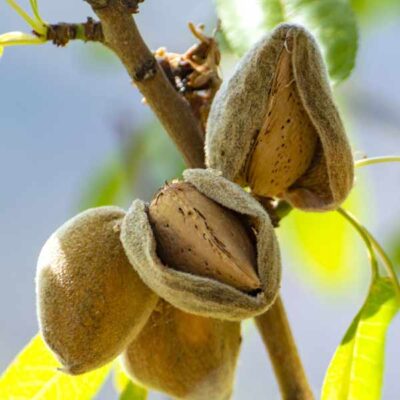Garden Plant: Texas Mission Almond Tree
Product Description: Texas Mission Almond Tree

Sweet Nut Texas Mission Almond Tree
- 500 Chill Hours
- Gorgeous White Blooms with Pink Centers
- Late Spring Bloom Time Protects Against Late Frosts
- Attractive, Spreading Form
- Grow Your Own Healthy Superfood
- Perfect for Hot, Dry Summers
- Disease Resistant
One of the most popular commercial Almond trees, Texas Mission Almond Tree (Prunus dulcis \’Texas Mission’) is easily grown at home. Also known as simply the Texas Almond, this beloved favorite produces very sweet nuts that are quite meaty.
This lovely tree makes an attractive addition to the landscape, with pretty white blooms with pink centers in late spring. Bloom times that come a bit later help protect your precious crop from late freezes!
Texas Mission Almond is known for being partially self-fertile. Technically, You’ll get nuts from a single tree. But You’ll enjoy a much larger bumper crop, if you can add a second variety nearby.
With pollination support, this tree becomes a reliable heavy producer of hard, well sealed almonds. These vigorous trees are easy to care for and maintain with moderate water usage.
Order Texas Mission Almond Tree for your Edible Landscape today!
How to Use Texas Mission Almond Tree in the Landscape
Yes, it makes sense to add a reliable source of nutrient-dense nuts to your landscape. Almonds are a powerhouse snack option with numerous health benefits.
But with Texas Mission, You’ll also gain a gorgeous ornamental tree. Lower your cholesterol, and enjoy eye candy, as well.
Growing your own is certainly a great way to increase food security and make the most of your sunshine! Almonds have similar growing requirements to other stone fruits, such as Nectarines and Apricots.
Add Texas Mission as a specimen tree. The spring blooms and open, spreading form add an evocative look to your landscape. Why not flank either side of the entrance to an outdoor dining room with a pair?
Use several varieties and plant a mini grove to maximize your nut production. If you have the room, allow the trees to grow to its full spread and height.
Have a tiny lot? Try summer pruning for size control. It’s easy to keep fruit trees smaller with annual pruning.
8 feet and under makes for a manageable harvest. Be sure to watch our YouTube videos to learn more about Backyard Orchard.
Almonds ripen from the top of the tree down. Harvest your crop once most of the hulls have begun to split by shaking the tree, or using a small stick to knock the branches.
It’s best to keep litter away from the base of your tree. Why not add the spent hulls to your compost pile?
Pro Plant Tips for Care
Plant in full sun for the best result. Almonds require at least 6 hours of direct sunlight for best results. A planting site that receives morning sunlight is best to dry the foliage quickly.
Almonds also require well-drained soil. If you need to improve drainage, elevate your planting by adding soil in a mound 12 to 18 inches tall by 3 feet wide. Add a decorative border to create a raised bed.
Provide a moderate amount of water on a regular basis to support your production. Apply a thick layer of mulch over the root system to cut down on surface evaporation.
Allow 6 inches of clearance around the trunk for air circulation. Spread to 3 feet outside the canopy.
Control the height and spread to keep the tree at a manageable size with summer pruning. Remove crossing branches in the interior of the tree in late winter. The goal is to increase the sunlight and air circulation in the canopy.
Texas Mission Almond Tree makes a wonderfully productive addition to your landscape. Add this protein-rich, healthy, homegrown nut tree today!


